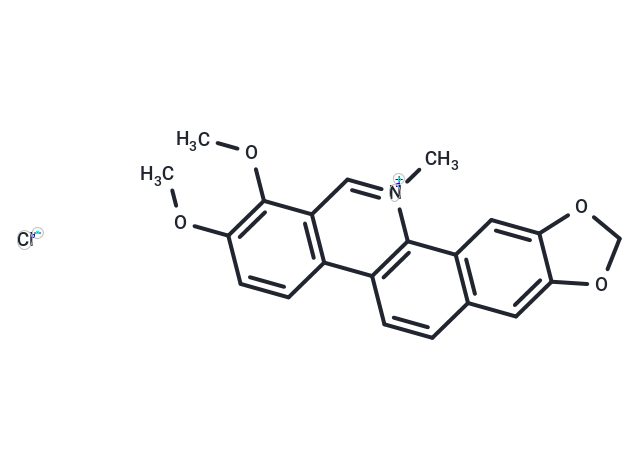Shopping Cart
- Remove All
 Your shopping cart is currently empty
Your shopping cart is currently empty

Chelerythrine Chloride is a cell-permeable inhibitor of protein kinase C, competitive with respect to the phosphate acceptor and non-competitive with respect to ATP.

| Pack Size | Price | Availability | Quantity |
|---|---|---|---|
| 5 mg | $63 | In Stock | |
| 10 mg | $90 | In Stock | |
| 25 mg | $180 | In Stock | |
| 50 mg | $315 | In Stock | |
| 100 mg | $576 | In Stock | |
| 500 mg | $1,260 | In Stock |
| Description | Chelerythrine Chloride is a cell-permeable inhibitor of protein kinase C, competitive with respect to the phosphate acceptor and non-competitive with respect to ATP. |
| Targets&IC50 | PKC:660 nM. |
| In vitro | Chelerythrine inhibits the BclXL-Bak BH3 peptide binding with IC50 of 1.5 μM. It displaced Bax, a BH3-containing protein, from BclXL. Mammalian cells treated with Chelerythrine undergoes apoptosis with characteristic features that suggest involvement of the mitochondrial pathway[1]. Chelerythrine treatment inhibits LPS-induced TNF-α level and NO production in LPS-induced murine peritoneal macrophages through selective inhibition of p38 mitogen-activated protein kinase (MAPK) and extracellular signal-regulated protein kinases 1 and 2 (ERK1/2) activation. In addition, the effects of chelerythrine on NO and cytokine TNF-α production can possibly be explained by the role of p38 MAPK and ERK1/2 in the regulation of inflammatory mediators expression[2]. Chelerythrine shows cytotoxic effect on the human monocytic leukaemia cells with LD50 value of 3.46 μM. Two hours after LPS stimulation, cells influenced by sanguinarine and Chelerythrine significantly decline the CCL-2 expression by a factors of 3.5 and 1.9[3]. Chelerythrine chloride significantly enhances the phosphorylation of ERK1/2 in a dose-dependent manner. In addition, chelerythrine chloride inhibits the phosphorylation of p38[4]. |
| In vivo | Chelerythrine exhibits substantial anti-inflammatory properties in vivo, notably in an experimentally induced endotoxic shock model in mice, by suppressing levels of LPS-induced tumor necrosis factor-alpha (TNF-α) and nitric oxide (NO) production in serum[2]. Additionally, chelerythrine chloride (5 mg/kg/day, i.p.) effectively induces apoptosis in RCC cells while maintaining a minimal toxicity profile in mice. Moreover, treatment with Chelerythrine Chloride results in a dose-dependent accumulation of p53[4]. |
| Cell Research | Chelerythrine is dissolved in DMSO. Cell viability is evaluated via MTT assay. Cells (2×103?HEK-293 cells/well and 3×103?SW-839 cells/well) in 100 μL medium are seeded into 96-well plates, and incubated for 12 h. Next, the medium in each well is replaced with medium containing various concentrations of Chelerythrine Chloride, and the cells are incubated at 37°C for an additional 24 and 48 h. Subsequently, 20 μL MTT (5 mg/mL) is added to each well. Following an additional incubation at 37°C for 4 h, the supernatant is removed, and 100 μL DMSO is added to each well. The absorbance values (read at 540 nm) are determined using the iMark? Microplate Absorbance Reader. The data are analyzed using Microplate Manager software (ver. 6.3; 1689520). |
| Molecular Weight | 383.83 |
| Formula | C21H18ClNO4 |
| Cas No. | 3895-92-9 |
| Smiles | [Cl-].COc1ccc2c(c[n+](C)c3c4cc5OCOc5cc4ccc23)c1OC |
| Relative Density. | 1.36g/cm3 |
| Storage | Powder: -20°C for 3 years | In solvent: -80°C for 1 year | Shipping with blue ice. | |||||||||||||||
| Solubility Information | DMSO: 3.8 mg/mL (9.9 mM), Sonication is recommended. | |||||||||||||||
Solution Preparation Table | ||||||||||||||||
DMSO
| ||||||||||||||||

Copyright © 2015-2025 TargetMol Chemicals Inc. All Rights Reserved.